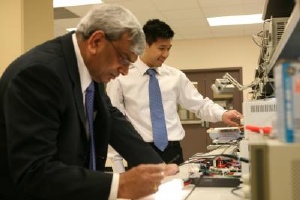Apr 7 2009
Long touted as an energy-saving alternative for home lighting, compact fluorescent lightbulbs (CFLs) now have the potential to be even more efficient, as well as dimmable, thanks to research at Queen's University.

Adopted by householders as a longer-lasting, energy efficient alternative to the traditional incandescent lightbulb, compact fluorescents consume one-third of the power and last 1,000 times longer than incandescent bulbs.
However, the Queen's researchers were motivated to solve two problems with CFLs - they don't work with dimmer switches, and, more importantly, their energy efficiency is compromised because of a problem known as poor power factor. In effect, only part of the energy a CFL consumes is used to power the bulb, resulting in wasted power.
"Consumer-grade CFLs need to be compact and inexpensive. Until now, the complicated circuitry needed to power these bulbs most efficiently has been too large and too costly for consumer-grade compact fluorescents," says professor of Electrical and Computer Engineering Praveen Jain, Canada Research Chair in Power Electronics and a world expert on electronic power supplies. "In its current form, the household CFL takes away the very benefit to the power grid that it was supposed to provide."
The Queen's innovation is timely, Dr. Jain adds, since widespread use of today's less efficient CFLs would reduce expected benefits to the global power grid. Many countries, including Australia and the European Union, have already begun phasing out incandescent bulbs in favor of the compact fluorescents. (Europe and Asia have established minimum standards for power factor for CFLs over 25 watts, but Canada and the U.S., which plan to ban incandescent by 2012, have not.)
The global market for compact fluorescents is estimated at $80 billion.
The poor power factor already has had an impact on commercial users of CFLs, who are charged for the extra power consumed by the current compact fluorescents. As for dimmability, Dr. Jain says it too is an efficiency issue and not just a nuisance for consumers. "In fact, when a CFL is used with a dimmer switch, its bulb can burn out sooner than expected," he says.
The solutions emerged when John Lam, a PhD candidate working with Dr. Jain, developed a compact, simplified circuitry and controller design that overcomes the power problem while also meeting consumers' need for a dimmable, inexpensive CFL. "Understanding the significance of the problem motivated me to work hard at finding a solution," Mr. Lam says.
The two main challenges were making the technology directly replaceable with existing designs, and economical to produce, says Dr. Jain. "We were able to develop a more power-efficient, dimmable and cost-effective CFL technology that can truly replace the power-hungry incandescent light bulbs. This makes it very attractive to the consumer market."
The work was carried out at Queen's Centre for Energy and Power Electronics Research (EPowER), which tackles key problems in the area of energy conservation and brings those solutions to industry.
PARTEQ Innovations, the technology transfer office of Queen's, will work with major CFL manufacturers to bring the technology to market.
"This is an excellent example of university research providing an innovative solution well in advance of a potential market problem," says John Molloy, President and CEO of PARTEQ. "The key to providing useable innovation is understanding the problems of existing technology and finding elegant solutions. Here we have a motivated researcher who saw a key problem and delivered the solution to an industry in need, in time to make a difference."